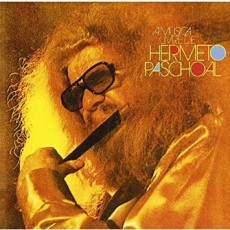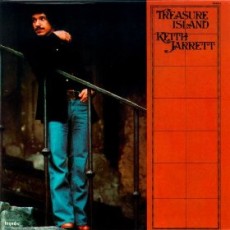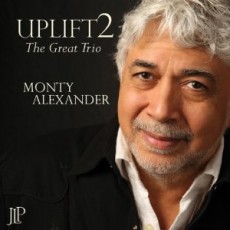
Daily Dose Of Jazz…
Hermeto Pascoal was born an albino on June 22, 1936 in Lagoa da Canoa, Alagoas, Brazil at a time when there was no electricity. He learned the accordion from his father and practiced for hours as his condition of birth did not allow him to work the fields.
Hermeto’s career began in 1964 with appearances on several Brazilian recordings alongside relatively unknown groups that included Edu Lobo, Elis Regina and Cesar Camargo Mariano, establishing widely influential new directions in post-bossa Brazilian jazz.
By 1966 he was playing in the Sambrasa Trio with Airto Moriera and Humberto Clayber releasing one album Em Som Maior. Then he and Airto joined Trio Novo and in 1967 renamed the group Quarteto Novo and released an album that launched the careers of Pascoal and Moreira. Pascoal would then go on to join the multi-faceted group Brazilian Octopus.
Pascoal initially caught the international public’s attention with an appearance on Miles Davis’s 1971 album Live-Evil, which featured him on three pieces he composed. Later collaborations involved fellow Brazilian musicians Airto and Flora Purim. From the late 1970s onward he has mostly led his own groups, that have included bassist Itibere Zwarg, pianist Jvino Santos-Neto and percussionists Nene, Pernambuco and Zabele.
Known as o Bruxo (the Sorcerer), Hermeto often makes music with unconventional objects such as teapots, children’s toys, and animals, as well as keyboards, button accordion, melodica, saxophone, guitar, flute, voice, various brass and folkloric instruments. Folk music from rural Brazil is another important influence in his work.
Between 1996 and 1997, Pascoal worked on a book project called the Calendário do Som, that contains a song for every day of the year, including 29 February, so that everyone would have a song for his or her birthday. He continues to perform, record and tour.
More Posts: accordion,flute,guitar,keyboard,melodica,saxophone,vocal

Daily Dose Of Jazz…
Keith Jarrett was born on May 8, 1945, in Allentown, Pennsylvania and had significant early exposure to music. He possessed absolute pitch and displayed prodigious musical talents as a young child. He began piano lessons just before his third birthday, and at age five he appeared on a TV talent program and by seven had given his first classical piano recital. During his teens he began leaning towards jazz, turned down classical training in Paris and attended Berklee College of Music
He started his career with Art Blakey and after his tenure as a Jazz Messenger moving on to play with Charles Lloyd and Miles Davis. Since the early 70s he has enjoyed a great deal of success in jazz, jazz-fusion, and classical music; as a group leader and a solo performer. His improvisations draw not only from the traditions of jazz but from other genres as well, especially Western classical music, gospel, blues, blues and ethnic folk music.
Jarrett has received the Polar Music Prize, the Leonie Sonning Music Prize, was inducted into the Down Beat Down Beat Hall of Fame, played with Jack DeJohnette, Charles Lloyd, Charlie Haden, Paul Motian, Dewey Redman, Airto Moreira, Palle Danielson and Jan Garbarek among others.
Jarrett’s compositions and the strong musical identities of the group members gave this ensemble a very distinctive sound. The quartet’s music is an amalgam of free jazz, straight-ahead post-bop, gospel music, and exotic, Middle-Eastern-sounding improvisations. He has played as a soloist, trio, returned also to classical music, incorporates vocalizations of grunts, squeals and tuneless singing. He continues to compose, record, perform and tour.
In 2003, Jarrett received the Polar Music Prize, the first (and to this day only) recipient not to share the prize with a co-recipient,[1] and in 2004 he received the Leonie Sonning Music Prize. In 2008, he was inducted into the Down Beat hall of Fame in the magazine’s 73rd Annual Readers’ Poll. He continues to tour and record.

Daily Dose Of Jazz…
Monty Alexander was born Montgomery Bernard Alexander on June 6, 1944 in Kingston, Jamaica. Discovering the piano at the age of 4, Alexander began taking classical music lessons at 6 and became interested in jazz at the age of 14. He started playing in clubs, and on recording sessions by Clue J & His Blues Blasters, deputizing for Aubrey Adams. Two years later, he directed his dance orchestra Monty and the Cyclones and played in the local clubs. Performances at the Carib Theater in Jamaica by Louis Armstrong and Nat King Cole left a strong impression on the young pianist.
In 1961 Alexander and his family moved to Miami, Florida, he went to New York in 1962 and started to play at the jazz club Jilly’s. In addition to performing with Frank Sinatra there, he also met and became friends with bassist Ray Brown and vibist Milt Jackson. In 1964, he went to California and recorded his first album “Alexander the Great” for Pacific Jazz at the age of 20.
He has recorded with Milt Jackson, Ernest Ranglin and Ed Thigpen, toured with Ernestine Anderson, steel pan player Othello Molineaux, Mary Stallings, Dizzy Gillespie, Benny Golson, and Frank Morgan among others. In some of successive trios he has collaborated with Oscar Peterson, Herb Ellis, Ray Brown, Mads Vinding, and Niels-Henning Orsted Pederson.
Alexander married the late great jazz guitarist Emily Remler in 1981, a union that would last only three years. In the 90s, Alexander formed a reggae band featuring all Jamaican musicians, releasing several reggae albums, including “Yard Movement” and “Stir It Up”, a collection of Bob Marley songs. Monty Alexander, pianist and melodica player, influenced by Art Tatum, Oscar Peterson, Wynton Kelly and Ahmad Jamal and the strong Caribbean influence and swinging feeling is consistently representative in his 67 albums as a leader and his numerous sideman collaborations as he continues to record, perform and tour.


